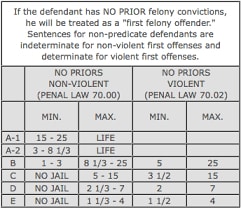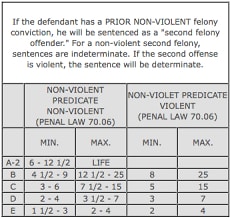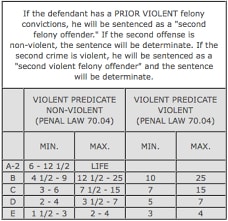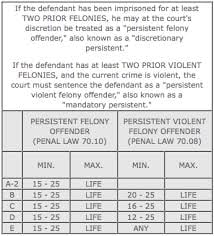Sentencing Chart in New York: A Closer Look
Just like the Federal Sentencing Guidelines, many states have their own version of sentencing guidelines, and sentencing charts. The State of New York is no exception. The Sentence Chart in New York for state crimes is particularly complicated.

New York state Sentencing Guidelines
In fact, there is not just one sentencing chart in New York, but four. Moreover, those four charts do not cover penalties for New York state drug offenses. While many New York criminal defense attorneys will tell you that there are too many complications and exceptions regarding New York sentencing law -- and their are -- this article will try to give you a fair assessment of the landscape of sentencing in New York State, including the sentencing chart in New York. The idea is just to give you an overall “sense” of New York sentencing. To get actual legal advice on what the sentencing chart in New York looks like for your particular circumstances, however, you should consult with a licensed New York criminal defense attorney, and rely on his or her advice.
Some New York Sentencing Basics
In New York there are two types of sentences – “determinate,” and “indeterminate.” The distinction is simple. A determinate sentence is a sentence that runs for a specific period of time, such as 5 years or 10 years. An indeterminate sentence, by contrast, is one that provides for a sentencing range, such as 5 to 15 years, or 25 years to life.
Courts typically impose indeterminate sentences for non-violent felonies. With those types of sentences, once the defendant has reached the minimum in the range he or she becomes eligible for parole. The Parole Board, then, determines how long the defendant will remain in prison.
For violent felonies, felonies involving drug offenses, and felonies where the defendant has a prior conviction for a violent felony, courts typically impose determinate sentences.
The Sentencing Chart New York
With regard to the sentencing chart in New York, the four charts work after answering three fundamental questions: (1) What is the classification of the crime charged? (2) Is the charged crime considered violent or non-violent? And (3) does the defendant have any prior felony convictions, and were any of them violent? Here is a more detailed breakdown of those questions:
- Crime Classification. The first thing you must identify is the classification of the crime with which you are charged. In New York, there are Class A, B, C, D, and E felonies. Class A felonies are the most serious, and Class E felonies are the least serious. Here are some examples:
- Class A - first-degree murder, or first-degree kidnapping
- Class B - first-degree manslaughter, or first-degree robbery
- Class C - second-degree burglary, or second-degree possession of a weapon
- Class D - second-degree assault, or first-degree sexual abuse
- Class E - fourth-degree grand larceny
- Violent vs. Non-Violent. The next thing you must identify is whether the crime with which you are charged is violent or non-violent. Generally, the distinction between the two is obvious, where murder is a violent crime and vandalism or stalking are non-violent. There are, however, some strange classifications. For example, arson is considered a non-violent felony and second-degree burglary is a violent felony, even though the elements of the crime of burglary do not require use of violence. In sum, the New York Penal Code defines which crimes are violent and non-violent.
- Prior Convictions. As with other sentencing schemes, like the Federal Sentencing Guidelines, a defendant’s prior convictions will impact his or her sentence in a subsequent case. Sentencing charts in New York further distinguish between defendants who have prior convictions for violent felonies compared to non-violent felonies.
Once those questions are answered you can turn to the charts.
As you can see below, the first Sentencing Chart in New York (Figure 1) gives potential sentences for defendants with no prior felony convictions. Accordingly, a person who committed first-degree robbery (a Class B felony) as a first offense will be sentenced to a determinate sentence that will be at least 5 years in prison.
Figure 1

New York sentencing guidelines chart for no prior felony convictions.
The second Sentencing Chart in New York (Figure 2) gives potential sentences for defendants with a prior non-violent felony conviction. So, a person with a prior non-violent conviction (such as stalking) who committed second-degree burglary (a Class C felony) will be sentenced to at least an indeterminate 3 to 6 years in prison.
Figure 2

New York sentencing guidelines chart for a prior non-violent felony conviction.
The third Sentencing Chart in New York (Figure 3) deals with potential sentences for defendants who have a prior violent felony conviction. Thus, a person who previously committed a violent felony (such as second-degree burglary) and who was just convicted of first-degree robbery (a Class B felony) will be sentenced to a determinate sentence that is at least 10 years in prison.
Figure 3

New York sentencing guidelines chart for one prior violent felony conviction.
Finally, the fourth Sentencing Chart in New York (Figure 4) deals with “persistent felony offenders” (aka “discretionary persistent”), who are people who have been imprisoned for at least two prior felonies. It also covers “persistent violent felony offenders” (aka “mandatory persistent”), who are people who have two prior violent felonies on their record and have just been convicted of another violent crime. So, if a defendant with two prior non-violent felonies committed a first-degree robbery (again a Class B violent felony) then he or she faces an indeterminate sentence of at least 20 to 25 years in prison.
Figure 4

New York sentencing guidelines chart for two or more prior violent felony convictions.
Remember that these charts do not cover drug offenses. There are other sentencing charts that deal with New York state drug offenses.
Suffice it to say that the sentencing charts above demonstrate how harsh New York sentences can be. It also shows that there is a complexity to New York sentencing that can cause confusion. In that regard, be sure to discuss your specific circumstances with a New York criminal defense attorney.
If you have questions about federal sentencing law, or need a sentencing attorney for a federal sentencing matter, we welcome you to contact Brandon Sample, Esq. Call 802-444-HELP for more information.
Recommended for you
Ex Parte Communications By Judge With Jury Required Reversal Of Convictions
At Martin Bradley III’s trial for racketeering, mail fraud, wire fraud, and money laundering, the district court had two ex parte communications with the jury. Bradley’s defense lawyers did not become aware of notes until after his appeal. Bradley filed a 2255 motion arguing, in addition to other things, that the court had violated Rule…
Supervised Release Cannot Be Revoked After Supervision Term Ends
Anthony Holman’s supervised release was revoked for failing to pay restitution and picking up a new charge. However, the violation petition was not submitted until after Holman’s term of supervision had already expired. No summons was pending at the time either. Generally, whenever a U.S. Probation Officer believes that a defendant has violated his or…
Burrage Applies Retroactively To Cases On Collateral Review
In Burrage v. United States, 134 S. Ct. 881 (2014), the Supreme Court held that “at least where use of the drug distributed by the defendant is not an independently sufficient cause of the victim’s death or serious bodily injury, a defendant cannot be liable under the penalty enhancement provision of 21 U.S.C. § 841(b)(1)(C)…




